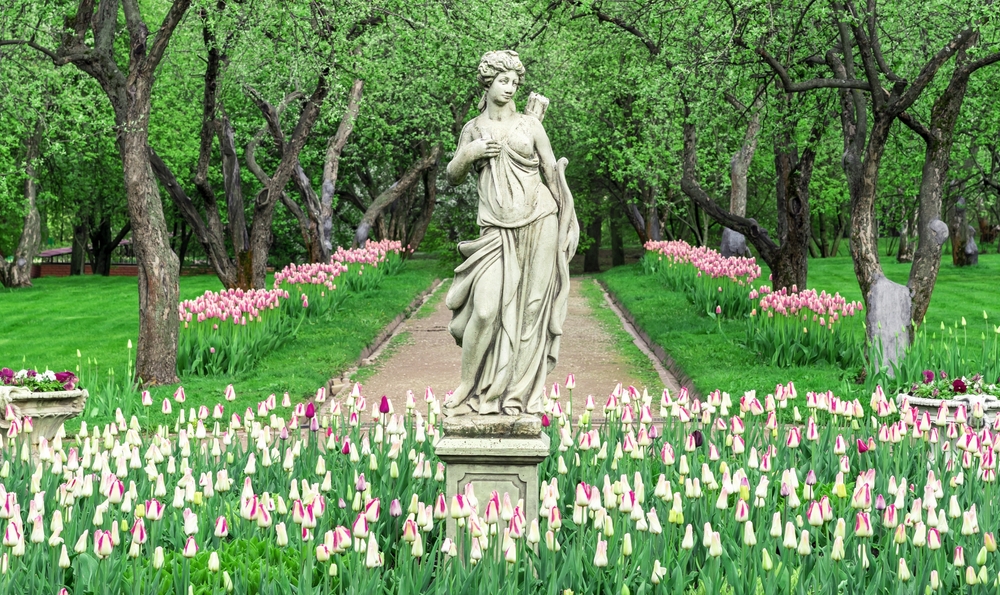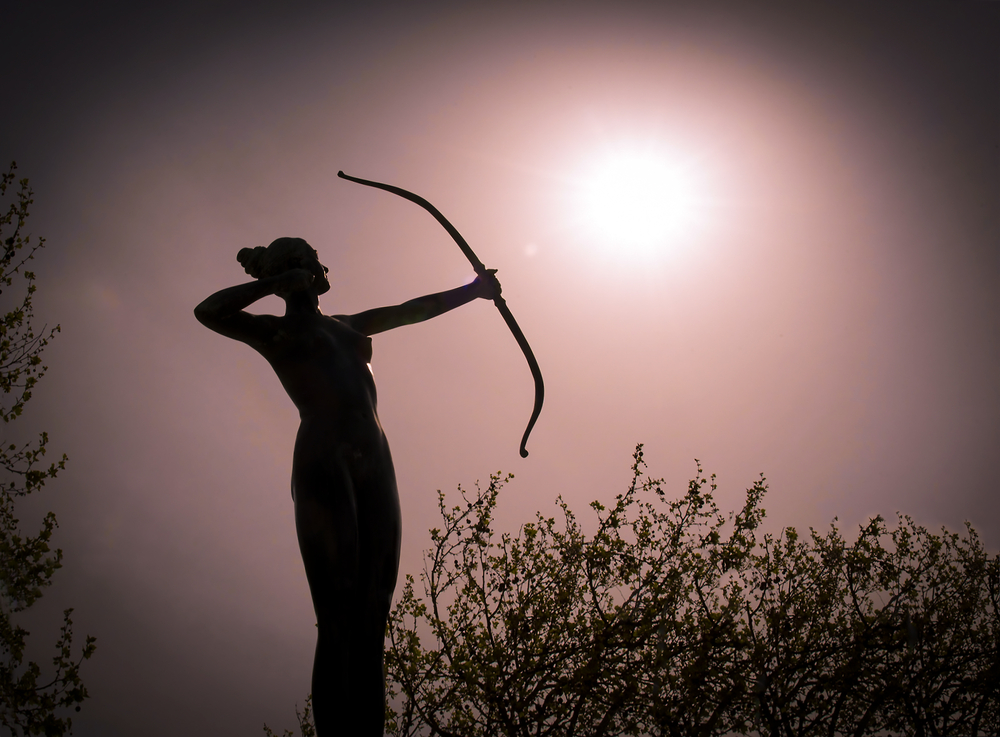Artemis, the goddess of the hunt, is a captivating figure in Greek mythology. Whether you're a mythology buff or simply curious about the tales of old, Artemis's story offers many fascinating myths, legends, and powers that echo the human experience. Let's explore who Artemis is, her significance in Greek mythology, and the symbols and stories that define her.
Jump to:
Who is Artemis?

Artemis is a figure of immense complexity and fascination in Greek mythology. Known as the Greek goddess of the hunt, she is also associated with wilderness, childbirth, virginity, and the protection of young girls. Artemis's identity as the goddess of animals and hunting reflects her deep connection to nature and her role as a protector of the natural world.
What was Artemis the goddess of?
Her primary association is with the hunt, embodying the skills and attributes of a master hunter. Artemis is often depicted with a bow and arrows, symbolising her prowess in hunting and her role as a protector of the natural world. She is also known as a goddess of childbirth, offering protection to women and infants. Her virginity symbolises her independence and autonomy, setting her apart as a deity who fiercely guards her freedom and the sanctity of the natural world.
Recommended for you!
Best SellersMyths and Legends Surrounding Artemis
Artemis is at the heart of numerous myths and legends that highlight her strengths, vulnerabilities, and valuable lessons. Here are five captivating myths that shed light on her character and the values she embodies.
The Birth of Artemis
Born to Zeus, the king of the gods, and Leto, a Titaness, Artemis's arrival into the world was fraught with challenges. Her mother, Leto, faced the wrath of Hera, Zeus's wife, who forbade her from giving birth on terra firma. The island of Delos provided refuge, and it was here that Artemis was born, immediately showcasing her divine capabilities by assisting in the birth of her twin brother, Apollo.
Artemis and Orion: The Tragedy of Forbidden Love
The story of Artemis and Orion is a tale of companionship that borders on the brink of love. Orion, a skilled hunter, earned Artemis's respect and perhaps her heart. Their close bond sparked jealousy in Apollo, Artemis's twin brother, who saw Orion's presence as a threat to Artemis's vow of chastity. Apollo's deceit led Artemis to accidentally kill Orion, a mistake that filled her with immense grief. Out of her love and regret, Artemis placed Orion in the sky as a constellation, immortalising their story among the stars.
Artemis and Actaeon: The Price of Transgression
The legend of Actaeon unfolds a grim tale of punishment for those who disrespect the goddess's privacy. Actaeon, a mortal hunter, stumbled upon Artemis bathing and was caught spying on her. Enraged by this violation, Artemis transformed Actaeon into a stag. His own hunting dogs, unable to recognise their master, tore him apart.
Artemis and Callisto: The Transformation of a Companion
Callisto was a devoted follower of Artemis and took a vow of chastity to remain with the goddess. However, Zeus, smitten by Callisto, disguised himself and seduced her. When Artemis discovered Callisto's pregnancy, she felt betrayed. In some versions, Artemis turns Callisto into a bear; in others, it is Hera or Zeus who enacts the transformation. Eventually, Callisto and her son, Arcas, were placed in the sky as the constellations Ursa Major and Ursa Minor, illustrating the themes of innocence, betrayal, and transformation.
Artemis and the Aloadae: Defending Olympus
The Aloadae, giant twins Otus and Ephialtes, sought to challenge the gods and capture Olympus. They attempted to stack mountains to reach the heavens and even sought to abduct Artemis and Hera to be their wives. Artemis, however, devised a cunning plan to protect herself and the home of the gods. She transformed herself into a deer and darted between them. Mistaking her for game, the twins threw their spears, accidentally killing each other in their attempt to catch the deer.
Artemis's Symbols and Powers

What is Artemis's symbol?
The bow and arrow are Artemis's most recognised symbols, representing her skills as a hunter and warrior. The moon, a deer, and the cypress tree are also associated with Artemis, each symbolising different aspects of her divine nature and powers. The moon reflects her connection to the night and her brother Apollo, the sun god, creating a balance between day and night. The deer, a creature of the woods, represents her dominion over animals and the wilderness. The cypress tree, evergreen and enduring, symbolises death and mourning but also immortality and eternal life.
The Powers of Artemis
Artemis's powers are varied. She has the ability to control animals and the natural environment, commanding respect from both predators and prey. Her skills as an archer are unmatched, allowing her to protect those under her care while also dispensing swift justice to those who transgress against her or the natural order. As a goddess of childbirth, Artemis offers protection and aid to women in labour, ensuring the safe delivery of infants.
Artemis’s Legacy

Artemis’s story, rich with themes of independence, environmentalism, and strength, continues to inspire and resonate across various forms of expression.
The Constellation of Artemis
The night sky pays homage to Artemis through the constellation traditionally known as Orion, a tribute to her myth with Orion. This celestial pattern underscores her enduring presence in both mythology and astronomy.
Artemis in Sculpture and Art
Across the world, sculptures and statues capture Artemis's essence, often portraying her as a skilled huntress. The famous Artemis of Ephesus statue, for instance, reflects her as a deity of fertility and protection, showcasing the variety of her worship. Modern paintings, drawings, and digital artworks continue to explore her symbolism, depicting her in various roles that highlight her autonomy, connection to the natural world, and feminine strength.
Literary Tributes to Artemis
Literature, from ancient plays to contemporary novels, often casts Artemis as a figure of feminist strength and protector of the environment. These stories bridge the ancient and the modern, allowing Artemis to continue influencing and inspiring discussions on autonomy, environmental stewardship, and the power of the divine feminine.
Frequently Asked Questions About Artemis
Is Artemis Asexual?
The concept of asexuality, as understood today, doesn't directly translate to ancient mythological contexts. However, Artemis is often described as a virgin goddess who swore never to marry, dedicating herself to the hunt and the protection of the natural world and young maidens. This vow symbolises her autonomy and independence, traits highly valued in her stories.
Who Did Artemis Turn into a Girl?
A fascinating tale involves a young hunter named Siproites, who, according to some versions of the myth, accidentally saw Artemis bathing. As punishment or protection — interpretations vary — Artemis transformed him into a girl. This story highlights themes of privacy, transformation, and perhaps the fluidity of identity.
Were Apollo and Artemis in Love?
Apollo and Artemis were twin siblings and shared a deep bond of affection and mutual respect. Their love was fraternal, not romantic, characterised by their joint adventures and shared duties. Their relationship exemplifies sibling loyalty and support rather than romantic love.
Is Artemis a Virgin?
Artemis is often referred to as a virgin goddess. This aspect of her identity symbolises her sovereign, untamed nature. Her virginity represents her independence and self-sufficiency, standing apart from the traditional roles of wife and mother assigned to women in ancient times.
What is the Sacred Number of Artemis?
The number seven is frequently associated with Artemis, reflecting her connection to the natural world and its cycles. This number echoes the phases of the moon, a celestial body closely linked to Artemis, and signifies completeness and perfection in various cultural and religious contexts.
What Are Artemis's Weaknesses?
While not often discussed in terms of weaknesses, Artemis's fierce protection of her privacy and her followers could be seen as a double-edged sword. Her swift retaliation against perceived threats or disrespect, as illustrated in the myths of Actaeon and Orion, reflects a zero-tolerance policy that leaves little room for forgiveness or understanding.
What Flowers Are Associated with Artemis?
Several flowers are associated with Artemis, signifying different aspects of her nature and mythology. Wildflowers, in general, symbolise her connection to the wilderness. Amaranth, a flower that never fades, symbolises her eternal youth and the immortality of nature.
What Happens if You See Artemis Bathing?
The myth of Actaeon is a cautionary tale about the consequences of invading Artemis's privacy. Actaeon, who stumbled upon Artemis bathing and watched her, was transformed into a stag and torn apart by his own hounds. This story underscores the sanctity of privacy and the severe repercussions of disrespecting the goddess.
Recommended for you!
Best SellersDiscover Greek Mythology with Centre of Excellence
Study the captivating world of deities, heroes, and ancient tales with our Greek Mythology Diploma Course, tailored to share fascinating mythological stories and their enduring impact on culture.
Why Centre of Excellence?
- Inclusivity: We believe in making education accessible to all. That's why we've priced our Greek Mythology course to be as inclusive as possible, ensuring everyone has the opportunity to explore these timeless tales.
- Learn at Your Own Pace: Our courses are crafted to fit into your life. With the flexibility to study at your own pace, you can seamlessly integrate this journey into mythology with your daily routine, enriching your knowledge without disrupting your lifestyle.
- Comprehensive Curriculum: The course covers a wide range of mythological narratives, from the Olympian gods to the exploits of ancient heroes. It addresses a variety of interests and enhances your understanding of this fascinating subject.
- Dedicated Support: Enrolling in our course means gaining access to dedicated tutor support and joining a community of like-minded learners. This network provides encouragement and assistance, making your learning experience both enriching and supportive.
Special Offer
We are excited to offer our Greek Mythology Diploma Course at a special discounted rate of £29, offering savings of over £100!













